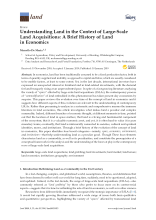Land Library Search
Through our robust search engine, you can search for any item of the over 73,000 highly curated resources in the Land Library.
If you would like to find an overview of what is possible, feel free to peruse the Search Guide.
/ library resources
Showing items 1 through 9 of 46.In economics, land has been traditionally assumed to be a fixed production factor, both in terms of quantity supplied and mobility, as opposed to capital and labor, which are usually considered to be mobile factors, at least to some extent.
Although the Orang Asli are the original, indigenous peoples of Peninsular Malaysia, they have been largely excluded from the country’s economic growth of recent decades.
The territorial planning and the management of urban surfaces force the decrease of green spaces in urban landscapes.
Land resources are the basis of economic and territorial development of any country.
Type of land use is a territory of land surface according to its natural characteristics and the current economic use of the land. In relation to the changing economic environment, land monitoring institutions are investigating and implementing methods for obtaining new data on land use pattern.
Land resources of Ukraine, having economic, social, natural, cultural and historical significance, mainly are located within rural areas.
During the last 50 years the humus content in the arable layer of the soil in the basic agrarian regions of Ukraine (steppe and forest steppe) has diminished by 15−18 %.
The current state of agricultural production space is the outcome of centuries of human activity, as conditioned by socio-economic, legal, and political factors.
Agricultural transport roads play an important role not only from the point of view of individual farm holdings, but also the general development of rural areas.



